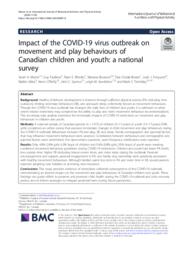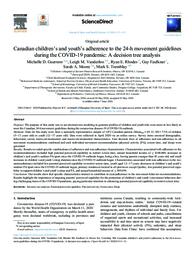Rhodes, Ryan E.
Person Preferred Name
Ryan E. Rhodes
Related Works
Content type
Digital Document
Abstract
This paper explores patterns of increased/ decreased physical activity, sedentary and sleep behaviours among Canadian children and youth aged 5-17 years during the COVID-19 pandemic, and examines how these changes are associated with the built environment near residential locations. A cluster analysis identified two groups who were primarily distinguished by the changes in outdoor activities. Compliance to 24-hour movement guidelines was low among both groups. For children, houses (versus apartments) was correlated with increased outdoor activities; proximity to major roads was a barrier. For youth, low dwelling density, and access to parks in high-density neighbourhoods, increased the odds of increased outdoor activities during the pandemic. Our findings can inform future urban and health crisis planning practices by providing new insights into the desirable public health messaging and characteristics of healthy and resilient communities. [ABSTRACT FROM AUTHOR]
Origin Information
Content type
Digital Document
Abstract
To reduce the spread of COVID-19, public health authorities across the country have recommended that Canadians keep their distance, wash their hands, and stay home. To enforce these measures, restrictions on outdoor behaviour have been implemented, limiting access to parks and recreational outdoor spaces. New evidence shows that COVID-19 restrictions are associated with an overall lower amount of time spent in outdoor play among Canadian children and youth. This is concerning, as outdoor play is important for children’s physical and mental health and helps provide them with a sense of control during times of uncertainty and stress. As policies on access to the outdoors during the COVID-19 outbreak vary by province, it is possible that policy differences have led to regional differences in changes in outdoor play among children and youth. In this commentary, we examine regional differences in outdoor play among children and youth across Canada, and the association between provincial policies related to COVID-19 and outdoor play. We argue that through the recovery process, in the event of a second wave of infections, and in preparing for future public health challenges, policy decisions should consider ways to preserve outdoor play for Canadian children and youth.
Origin Information
Content type
Digital Document
Abstract
Background: Healthy childhood development is fostered through sufficient physical activity (PA; including time outdoors), limiting sedentary behaviours (SB), and adequate sleep; collectively known as movement behaviours. Though the COVID-19 virus outbreak has changed the daily lives of children and youth, it is unknown to what extent related restrictions may compromise the ability to play and meet movement behaviour recommendations. This secondary data analysis examined the immediate impacts of COVID-19 restrictions on movement and play behaviours in children and youth.<p>
<p>Methods: A national sample of Canadian parents (n = 1472) of children (5–11 years) or youth (12–17 years) (54% girls) completed an online survey that assessed immediate changes in child movement and play behaviours during the COVID-19 outbreak. Behaviours included PA and play, SB, and sleep. Family demographics and parental factors that may influence movement behaviours were assessed. Correlations between behaviours and demographic and parental factors were determined. For open-ended questions, word frequency distributions were reported.<p>
<p>
Results: Only 4.8% (2.8% girls, 6.5% boys) of children and 0.6% (0.8% girls, 0.5% boys) of youth were meeting combined movement behaviour guidelines during COVID-19 restrictions. Children and youth had lower PA levels, less outside time, higher SB (including leisure screen time), and more sleep during the outbreak. Parental encouragement and support, parental engagement in PA, and family dog ownership were positively associated with healthy movement behaviours. Although families spent less time in PA and more time in SB, several parents reported adopting new hobbies or accessing new resources.<p>
<p>
Conclusions: This study provides evidence of immediate collateral consequences of the COVID-19 outbreak, demonstrating an adverse impact on the movement and play behaviours of Canadian children and youth. These findings can guide efforts to preserve and promote child health during the COVID-19 outbreak and crisis recovery period, and to inform strategies to mitigate potential harm during future pandemics.
Origin Information
Content type
Digital Document
Abstract
Purpose
The purpose of this study was to use decision tree modeling to generate profiles of children and youth who were more or less likely to meet the Canadian 24-h movement guidelines during the coronavirus disease-19 (COVID-19) outbreak. <p>
<p>Methods
Data for this study were from a nationally representative sample of 1472 Canadian parents (Meanage = 45.12, SD = 7.55) of children (5–11 years old) or youth (12–17 years old). Data were collected in April 2020 via an online survey. Survey items assessed demographic, behavioral, social, micro-environmental, and macro-environmental characteristics. Four decision trees of adherence and non-adherence to all movement recommendations combined and each individual movement recommendation (physical activity [PA], screen time, and sleep) were generated. <p>
<p>
Results
Results revealed specific combinations of adherence and non-adherence characteristics. Characteristics associated with adherence to the recommendation(s) included high parental perceived capability to restrict screen time, annual household income of ≥ $100,000, increases in children's and youth's outdoor PA/sport since the COVID-19 outbreak began, being a boy, having parents younger than 43 years old, and small increases in children's and youth's sleep duration since the COVID-19 outbreak began. Characteristics associated with non-adherence to the recommendation(s) included low parental perceived capability to restrict screen time, youth aged 12–17 years, decreases in children's and youth's outdoor PA/sport since the COVID-19 outbreak began, primary residences located in all provinces except Quebec, low parental perceived capability to support children's and youth's sleep and PA, and annual household income of ≤ $99,999. <p>
<p>
Conclusion
Our results show that specific characteristics interact to contribute to (non)adherence to the movement behavior recommendations. Results highlight the importance of targeting parents’ perceived capability for the promotion of children's and youth's movement behaviors during challenging times of the COVID-19 pandemic, paying particular attention to enhancing parental perceived capability to restrict screen time.
Origin Information




